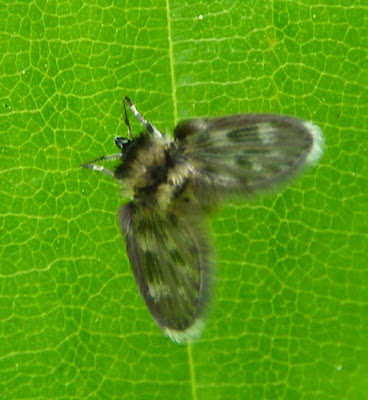
This morning I noticed two of these little flying insects in the woods beside the large lake in Reading University grounds. They were tiny: their wing-span was about 7mm. The black and yellow banding and their hairy bodies suggested to me that they may be bee-mimics, but surely they are too small to fool birds into thinking they might be bees?
At first I assumed these little insects must be moths because of their hairy wings, but I couldn't find anything like them on the UK Moths website. It was only after quite a bit of Googling that I came across a reference to moth flies, a group of primitive dipteran flies. Their classification is, as far as I can take it:
- Kingdom Animalia (Animals)
- Phylum Arthropoda (Arthropods)
- Class Insecta (Insects)
- Order Diptera (Flies)
- Suborder Nematocera (Non-Brachycera)
- Infraorder Psychodomorpha
- Family Psychodidae (Moth Flies and Sand Flies)
- Subfamily Psychodinae (Moth Flies)
- Genus: ?
- Species: ?
A few years ago we had similar little black flies living in the overflow of our bathroom hand-basin. I didn't take any photos of them but they must have been drain flies which are very similar. However, they all disappeared when I squirted some bleach down the overflow, and have never reappeared.
 Sun 2009-04-26
Sun 2009-04-26 
